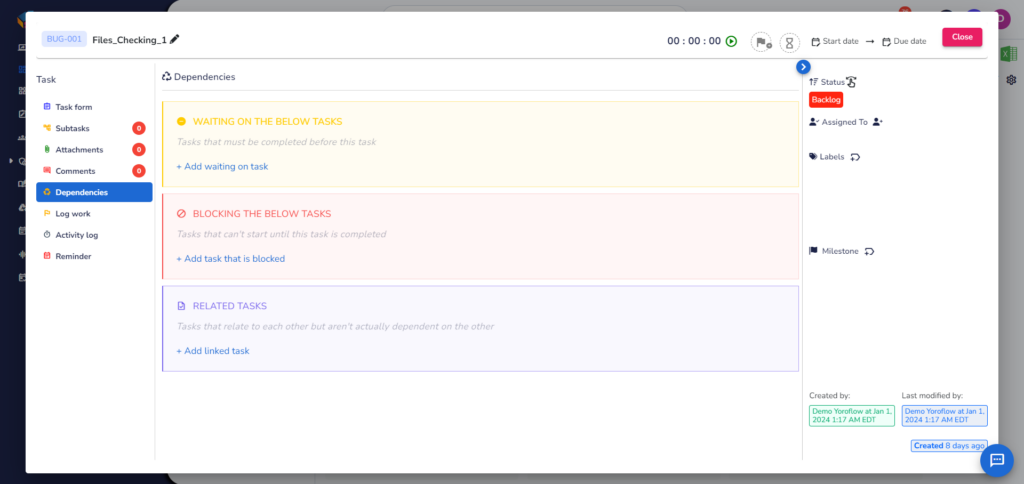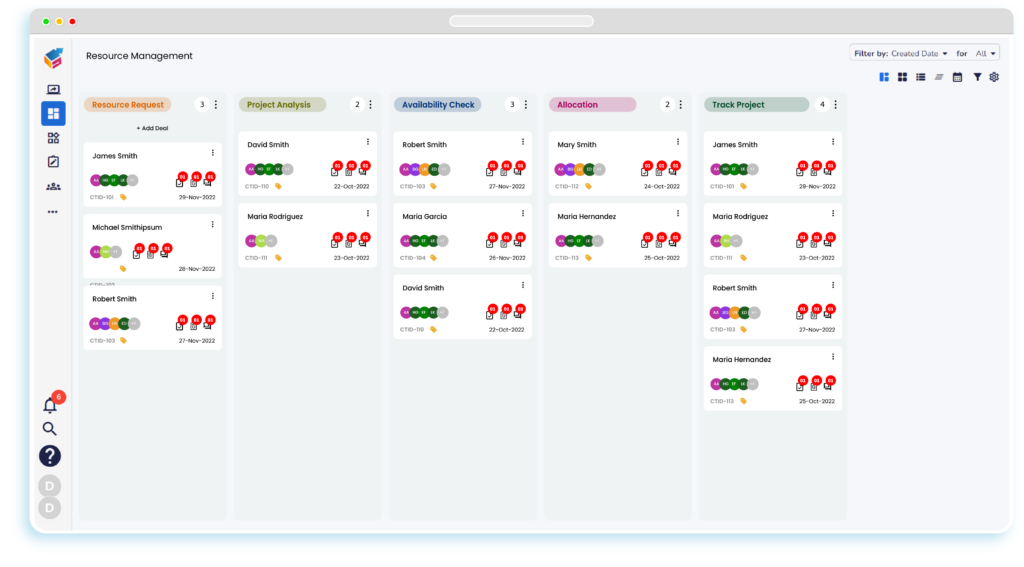Table of Contents
Effective resource forecasting serves as a formidable asset in project management. When executed accurately, it enables you to predict impending tasks, set appropriate start times, and assign suitable team members. Consider it your practical superpower, endowing you with the extraordinary ability to discern the future trajectory of your projects effortlessly.
This guide is dedicated to elucidating the intricacies of resource forecasting. We will dissect it into straightforward steps, offering valuable tips along the way. Additionally, we’ll underscore the role of tools such as Yoroproject as indispensable allies in this endeavor.
Stay tuned, and together, let’s harness and amplify your project management superpowers!
What is resource forecasting?
Resource forecasting is a strategic process within project management that involves predicting and planning for the future allocation of resources such as personnel, materials, and time. The primary goal is to anticipate the demand for resources and ensure that the necessary assets are available when needed. This proactive approach allows project managers to optimize resource utilization, prevent bottlenecks, and enhance overall project efficiency.
The benefits of resource forecasting
Resource forecasting offers several benefits in the realm of project management, contributing to the overall success and efficiency of projects. Here are some key advantages:
- Optimized Resource Utilization: By accurately predicting resource demands, project managers can allocate resources more efficiently, ensuring that they are utilized to their full potential. This helps in preventing overallocation or underutilization of resources, leading to improved productivity.
- Improved Planning and Scheduling: Resource forecasting allows for better planning and scheduling of project tasks. Project managers can anticipate peak resource demands, plan for critical phases, and establish realistic timelines, resulting in smoother project execution.
- Cost Savings: Efficient resource allocation minimizes unnecessary costs associated with overstaffing or rushed resource procurement. By aligning resource needs with actual demand, organizations can optimize their budgets and achieve cost savings.
- Enhanced Risk Management: Resource forecasting involves assessing potential risks and challenges related to resource availability. This proactive approach enables project managers to identify and mitigate risks early on, reducing the likelihood of delays or disruptions.
- Increased Team Productivity: Assigning the right team members to specific tasks based on their skills and availability improves overall team productivity. Team members can focus on their areas of expertise, leading to higher-quality outputs and faster task completion.
- Realistic Project Expectations: Resource forecasting provides a realistic view of what can be achieved within a given timeframe. This helps in setting accurate expectations with stakeholders and clients, reducing the likelihood of unmet deadlines or project scope creep.
- Efficient Communication: Clear communication regarding resource needs and availability fosters better collaboration among team members. Team members are aware of their responsibilities and can plan their work, accordingly, leading to a more cohesive and synchronized project team.
- Continuous Improvement: Analyzing the accuracy of resource forecasts and comparing them to actual outcomes provides valuable insights for future projects. This iterative process allows organizations to continually improve their resource forecasting techniques and enhance overall project management practices.
What are the steps in forecasting resources?
The process of forecasting resources involves several key steps to accurately predict and plan for the allocation of resources in a project. Here are the steps typically involved in resource forecasting:
Define Project Scope and Objectives:
- Clearly articulate the scope, objectives, and deliverables of the project.
- Understand the key milestones and phases that require resource allocation.
Identify Project Tasks and Activities:
- Break down the project into specific tasks and activities.
- Chemical cleaning should be done by a qualified and experienced, and OEM approved vendor.

Estimate Resource Requirements:
- Estimate the type and quantity of resources needed for each task.
- Consider personnel, equipment, materials, and any other relevant resources.
Assess Resource Availability:
- Evaluate resource availability, considering existing commitments, vacations, or other potential constraints.
- Consider the skills and expertise required for specific tasks.
Create a Resource Schedule:
- Develop a schedule that outlines when each resource is needed for each task.
- Align the schedule with project milestones and deadlines.
Allocate Resources to Tasks:
- Assign specific resources to each task based on their availability, skills, and the requirements of the task.
- Ensure a balanced distribution of workload among team members.
Consider Project Constraints:
- Identify and address any constraints or limitations that may impact resource allocation, such as budget constraints, equipment availability, or external dependencies.
Account for Contingencies:
- Build contingency plans for unexpected changes or challenges in resource availability.
- Anticipate and plan for potential risks that may affect resource forecasts.
Utilize Technology and Tools:
- Leverage project management software and forecasting tools to streamline the process.
- Automate the tracking of resource allocation and adjustments as the project progresses.

Monitor and Update:
- Regularly monitor resource usage against the forecasted plan.
- Update the resource forecast as the project evolves, considering any changes in scope, timelines, or resource availability.
Communicate with Stakeholders:
- Keep stakeholders informed about resource forecasts, potential risks, and any adjustments made to the plan.
- Foster transparent communication to manage expectations effectively.
Evaluate and Learn:
- Conduct a post-project evaluation to compare actual resource usage with the initial forecast.
- Analyze the accuracy of the resource forecast and identify areas for improvement in future projects.
By following these steps, project managers can create a comprehensive resource forecast that aligns with project goals, optimizes resource utilization, and facilitates successful project execution.
5 challenges of resource forecasting and tips to resolve them
Resource forecasting in project management can face various challenges that may impact the accuracy and effectiveness of the predictions. Here are five common challenges along with tips to help resolve them:
Uncertain Project Scope:
- Challenge: Changes in project scope can significantly impact resource requirements. Unexpected additions or modifications to project tasks may lead to inaccurate forecasts.
- Resolution: Regularly review and update the project scope. Foster open communication with stakeholders to identify and document any changes promptly. Adjust resource forecasts, accordingly, considering the evolving project scope.
Limited Data and Historical Information:
- Challenge: Lack of historical data or incomplete information on resource usage can make it challenging to make accurate predictions.
- Resolution: Gather as much historical data as possible from past projects. Use project management tools to track resource utilization and learn from previous experiences. In the absence of historical data, consider using industry benchmarks and expert opinions to inform resource forecasts.
Dynamic Team Availability:
- Challenge: Team members may have fluctuating availability due to vacations, unforeseen absences, or conflicting priorities, making it difficult to predict resource allocation accurately.
- Resolution: Maintain open communication with team members to stay informed about their availability. Use resource management tools that allow team members to update their schedules in real-time. Establish contingency plans for resource shortages and be prepared to adjust allocations as needed.
External Dependencies:
- Challenge: Projects often rely on external resources or third-party vendors, and delays or changes in their availability can impact the overall project timeline.
- Resolution: Clearly identify and communicate external dependencies early in the project. Maintain a proactive relationship with external partners and vendors, regularly checking in on their availability and potential challenges. Develop contingency plans to address delays caused by external factors.
Inaccurate Task Duration Estimates:
- Challenge: Incorrect estimates of task durations can lead to misaligned resource forecasts. Underestimating the time required for tasks may result in resource shortages, while overestimation can lead to underutilization.
- Resolution: Work closely with task owners to ensure accurate estimates. Break down tasks into smaller, more manageable components for a more granular understanding. Use historical data and lessons learned from previous projects to refine duration estimates. Regularly revisit and adjust estimates as the project progresses.
Addressing these challenges requires a combination of proactive planning, effective communication, and the use of project management tools and technologies to enhance the accuracy of resource forecasting. Regularly reassessing and adjusting resource forecasts throughout the project lifecycle is essential to adapt to changing circumstances and ensure successful project outcomes.
Behold—an in-depth exploration of resource forecasting!
Proficiency in this process can markedly elevate your project management prowess, and with aids like Yoroproject, it’s now more accessible than before. Skillful forecasting holds the potential to enhance project delivery, elevate team spirit, and make a positive impact on your organization’s financial performance.
Take the plunge, initiate your forecasting journey, and let your inner project management superhero radiate. Cheers to a future brimming with smoothly executed projects, satisfied teams, and heightened productivity!




